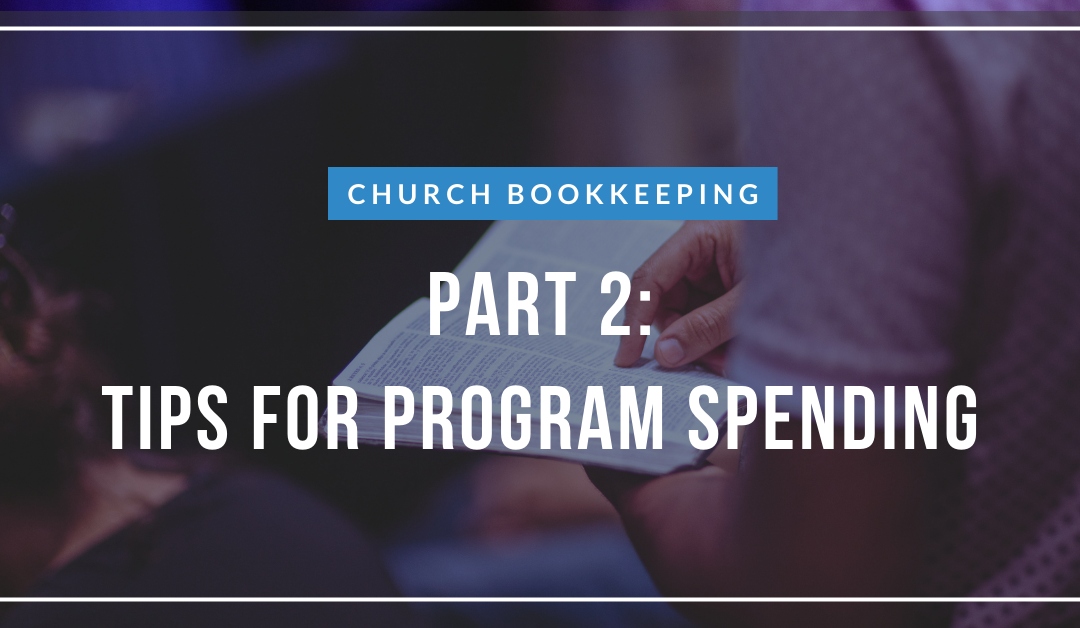Welcome to part two of our three part series on bookkeeping and finance specific to churches. This second part of the series covers program spending, restricted funds, and taxes. If you haven’t read part one it covers SAAS tools and services, I recommend reading that first since this part of the series builds on what was covered in part one, and you can look forward to the final part about budgeting.
Here in part two we will cover the aspects of church bookkeeping that often get overlooked as churches grow and operations and activities become more complex.
Program Spending
As a church grows, various ministries and programs start to take shape that require expenses, and sometimes income, to be tracked separately. Good examples of this are kids ministry, worship, building/operations — things that would often be considered “departments,” or “business segments” in the for-profit world. One option is to simply create new accounts for them, which works most of the time. However, what happens when the church wants to see supplies used by the kids ministry and the worship band separately? What if there are other accounts (food supplies, small equipment, etc.) that need to be tracked separately as well?
As this complexity grows we recommend creating “Classes” (a Quickbooks term) for each of the ministries. Terms for this vary across the accounting world but it’s essentially a way to show each ministry or program as a distinct column on the income statement. That way, it’s easier to see the goldfish crackers consumed (and sometimes inhaled) by the kids ministry separately from the muffins and croissants bought for the worship band’s Sunday breakfast.
The word of caution here is to only create “classes” for ministries where this type of separation is needed. It’s okay for other programs to exist as only an account since it’s easier to read an income statement containing three columns versus ten columns. As outsourced bookkeepers and solutions providers, this is a great opportunity for us to advise on what works best for each church’s specific needs and goals.
Restricted Funds
Most bookkeepers cringe when they hear the term “restricted funds,” and for good reason. In accounting this prompts potentially bitter memories of releasing expenses, changes to net assets, and tracking restricted income. This is usually a fair reaction because it can quite literally cause a headache with the multitude of accounting rules that dictate these funds.
Fortunately, all these requirements are only needed if the church is regularly audited according to U.S. GAAP standards. Since most churches do not fall under these standards, the process can be simplified more than you might realize!
What are “restricted funds” exactly? As with every non-profit in the country, each donation is given with an intent on how that donation will be used and organizations are bound by that donor intent. However, if churches are clear on how donations will be spent, and create a “general fund” with clear language that it will be used for general church operations and ministries it can safely be assumed that donors understand and are providing donations for that purpose. For this reason it is important that these expectations are clearly displayed or stated.
Problems arise when a donor states they would like their donation to be spent on a more specific purpose (i.e. choir robes, kids ministry, sprinkler repair, etc.). If the donation is accepted, then the donation is legally restricted to be used for that purpose. In most cases a quick conversation with the donor can convince them to change their designation to the general fund, but if not, that donation is now restricted and has to be tracked that way in the books.
It’s also perfectly normal for churches to intentionally set up a restricted fund especially if they need to raise funds for a special purpose. The most common example is a building fund set up to pay for a new roof or replace a furnace. This is most often associated with a special giving drive.
Whatever the case, the church needs to easily demonstrate two things in the books:
- How much money was collected for this purpose?
- How much money has been spent for this purpose?
Going back to the first section in this article the most effective way to answer these two questions is to set up a Class for the fund, especially if the expenses need to go to multiple accounts on the income statement. For almost all churches, using Classes will ensure that the expenses and income for the specific purpose are not mixed in with other general church giving and expenses and those two questions can be easily answered.
Taxes
I often hear the phrase “churches don’t pay taxes,” and while this is generally true there are some exceptions. These exceptions appear when churches start to engage in activities more commonly associated with for-profit companies. Here is a quick list of the more common exceptions:
- Selling books or merchandise
- Hosting a concert with paid public admission
- Collecting royalties for published content
- Receiving rent for parking lot spaces
- Fee income for a church-operated daycare
The term for these activities is “unrelated business income,” meaning they are unrelated to the normal operations of a church. All churches are required to fill out a 990 form to the IRS every year, but if they collect business-type income they are required to fill out a 990T form.
It’s important to note that just like with for-profit business some expenses related to these activities can be deducted against the income received, so it may be worth tracking the associated income and expenses using Classes, as mentioned above. Also, these types of income may be taxable to state government agencies. As outsourced bookkeepers it is important to be aware of all the income our church clients are receiving, and be able to advise them on if they are liable to pay taxes on some of their activities even if we are not the ones actually preparing the tax filings.
Final Thoughts
Currently, churches are coming under more and more scrutiny as we diversify our traditional institutions and as they change the scope and variety of ministries and services they offer. Because of this, it is important that churches stay under compliance with all tax and business laws. Keeping a clean set of books where it is easy to demonstrate how money is spent is crucial to building a healthy church.
It may seem complex to answer the many questions about how money is spent, but this process can be simplified immensely by working within the structure of a well thought out and organized budget. With clear, well formatted intentions, categories, and processes for delegating funds the process for reporting them only gets easier! Stop by next week for the final part of the series on church bookkeeping — budgeting!




